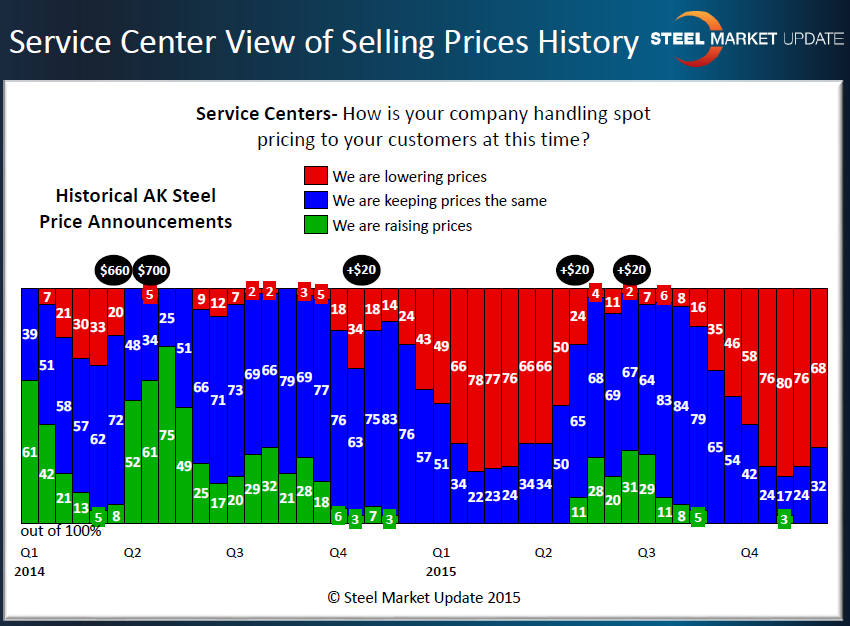SMU Data and Models

Distributor Spot Sale Prices Suggest Price Increase Imminent
Written by John Packard
December 8, 2015
Steel Market Update (SMU) has been analyzing service center spot pricing based on reports from manufacturing and distribution respondents to our flat rolled steel market questionnaire. SMU canvassed the market last week and we believe that the results suggests an uptick in spot pricing will come soon.
Manufacturing companies responding to our survey had 90 percent of their respondents reporting lower spot prices out of their service center suppliers. Manufacturers have been reporting their distributors as lowering spot prices in each of the past four survey periods (2 months).
At the same time, 68 percent of the service centers reported that their company was lowering spot pricing to their end user customers. This is down slightly from the 76 percent reported two weeks ago as well as the 75 and 80 percent calculated over the course of the previous survey.
In the past, SMU has considered a response level at, or above, 75 percent as the level of capitulation at the distributors. At that level the pain associated with selling at continually cheaper pricing puts the industry in a mindset that would allow it to accept a price increase out of the domestic steel mills. Our opinion is we have been at that level, as we were earlier this year, and the odds of a price increase have been growing over the past week or two. This is also similar to what we saw earlier this year.
The question is if the mills do announce a public price increase (as a number of mills have indicated that they will only take new spot orders at higher prices already) will be see sideways movement, a dead cat bounce (short term bounce in prices) or a longer term rise in steel prices?

John Packard
Read more from John PackardLatest in SMU Data and Models

SMU Scrap Survey: Sentiment Indices rise
Both current and future scrap sentiment jumped this month, though survey participants reported responses before key trade news was announced.

SMU Survey: Sentiment splits, buyers have better view of future than the present
SMU’s Steel Buyers’ Sentiment Indices moved in opposite directions this week. After rebounding from a near five-year low in late June, Current Sentiment slipped again. At the same time, Future Sentiment climbed to a four-month high. Both indices continue to show optimism among buyers about their company’s chances for success, but suggest there is less confidence in that optimism than earlier in the year.

SMU scrap market survey results now available
SMU’s ferrous scrap market survey results are now available on our website to all premium members. After logging in at steelmarketupdate.com, visit the pricing and analysis tab and look under the “survey results” section for “ferrous scrap survey” results. Past scrap survey results are also available under that selection. If you need help accessing the survey results […]

SMU flat-rolled market survey results now available
SMU’s latest steel buyers market survey results are now available on our website to all premium members. After logging in at steelmarketupdate.com, visit the pricing and analysis tab and look under the “survey results” section for “latest survey results.” Past survey results are also available under that selection. If you need help accessing the survey results, or if […]

SMU Survey: Sheet lead times stabilize, plate contracts
Mill lead times for sheet products were steady to slightly longer this week compared to our late June market check, while plate lead times contracted, according to steel buyers responding to this week’s market survey.

